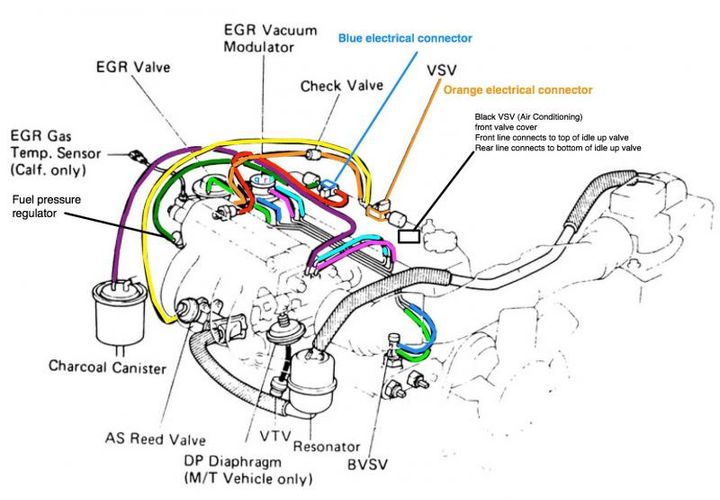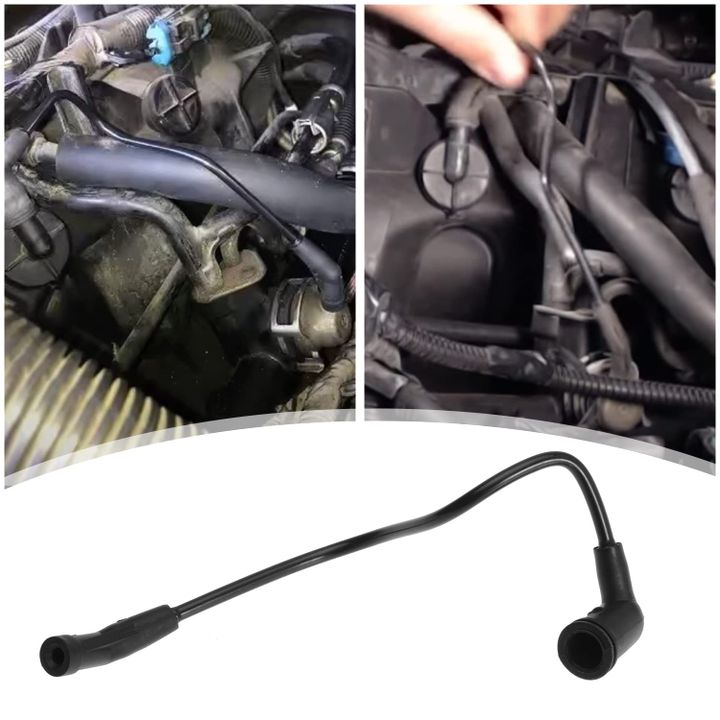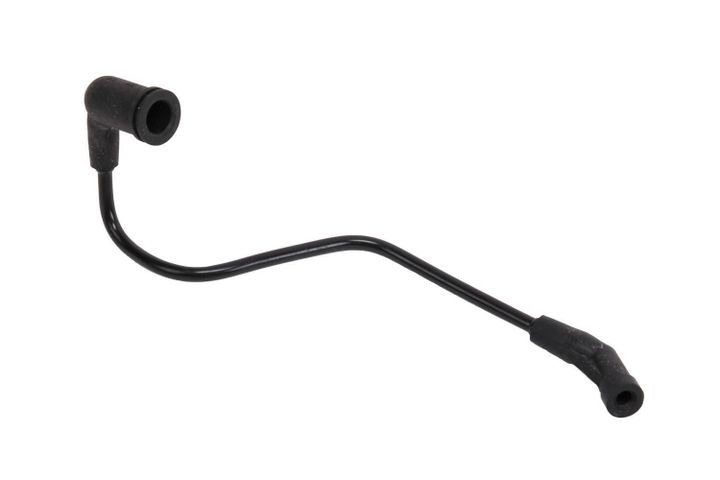


The fuel pressure regulator is a crucial component in modern fuel injection systems, responsible for maintaining the correct fuel pressure within the fuel rail. The vacuum line connected to the fuel pressure regulator plays a vital role in ensuring that the fuel pressure is adjusted based on the engine's operating conditions, particularly the manifold pressure. This line provides a reference signal to the regulator, allowing it to compensate for changes in manifold pressure and maintain a consistent pressure differential across the fuel injectors.

The vacuum line is responsible for transmitting the vacuum signal from the intake manifold to the fuel pressure regulator. This signal is essential for the regulator to adjust the fuel pressure accurately, ensuring that the correct amount of fuel is delivered to the engine. Without a properly functioning vacuum line, the fuel pressure can become erratic, leading to a host of performance issues, including poor acceleration, rough idling, and even stalling.
Throughout my career, I've encountered several recurring issues related to the vacuum line and fuel pressure regulator. Here are some of the most common culprits:
| Cause | Description |
|---|---|
| Cracked or Damaged Vacuum Line | Over time, the vacuum line can become brittle and develop cracks or damage due to heat exposure, vibrations, and age. Even a small crack can disrupt the vacuum signal, causing fuel pressure regulation problems. |
| Disconnected Vacuum Line | If the vacuum line becomes disconnected from either the regulator or the intake manifold, it will completely sever the vacuum signal, resulting in improper fuel pressure regulation. |
| Blocked or Restricted Vacuum Line | Debris, carbon buildup, or kinks in the vacuum line can restrict airflow, weakening or blocking the vacuum signal from reaching the regulator. |
| Faulty Fuel Pressure Regulator Diaphragm | Inside the fuel pressure regulator, a diaphragm is responsible for adjusting the fuel pressure based on the vacuum signal. If this diaphragm becomes torn or damaged, it can allow fuel to be sucked into the vacuum line during operation, which is a clear sign that the regulator needs replacement. |
When a customer brings in a vehicle with potential vacuum line or fuel pressure regulator issues, I follow a systematic approach to diagnose the problem accurately. Here are the steps I typically take:
Visual Inspection
Vacuum Line Test
Vacuum Signal Check
Performance Evaluation
I start by visually inspecting the vacuum line for any cracks, damage, or disconnections. I also check for kinks, blockages, or restrictions along the length of the line.
With the engine running, I remove the vacuum line from the regulator and check for any fuel being sucked into the line. If fuel is present, it's a clear indication that the regulator's diaphragm has failed and needs replacement.
If no fuel is present in the line, I check for the presence of a vacuum signal at the regulator port with the line removed. No vacuum at this port suggests a blockage or disconnection somewhere in the system.

I also consider any symptoms reported by the customer, such as erratic idle, hard starting, or poor performance, as these can be indicators of improper fuel pressure regulation.
Once the issue has been identified, it's time to address it through repair or replacement. Here are the typical procedures I follow:
Locate and disconnect the old vacuum line from the regulator and intake manifold.
Replace the vacuum line with a new line of the correct size and material, ensuring there are no kinks, restrictions, or excessive lengths.
Reconnect the new vacuum line securely to the regulator and manifold ports.
| Steps | Description |
|---|---|
| 1 | Depressurize the fuel system according to the vehicle's service manual. |
| 2 | Disconnect the fuel lines, vacuum line, and electrical connections to the regulator. |
| 3 | Remove the mounting bolts and carefully remove the old regulator. |
| 4 | Install the new regulator and reconnect all lines, fittings, and electrical connections. |
| 5 | Pressurize the fuel system and check for any leaks before starting the engine. |
Throughout my years of experience, I've learned a few valuable tips and preventive measures to help avoid vacuum line and fuel pressure regulator issues:
Use approved thread sealant on any threaded fittings to prevent air leaks.
Ensure vacuum lines are routed away from excessive heat sources, as heat can accelerate the degradation of the line material.
Replace any brittle, cracked, or damaged vacuum lines proactively, even if they're not causing immediate issues.
Inspect vacuum lines regularly during routine service and replace them based on the vehicle manufacturer's recommended intervals.
Avoid operating the vehicle with a known vacuum leak or fuel pressure issue, as this can lead to further complications and potential engine damage.
Use only the recommended fuel quality and octane rating for your vehicle, as low-quality fuel can contribute to regulator and fuel system issues.
The cost of addressing vacuum line and fuel pressure regulator issues can vary depending on the specific repair required and the make and model of the vehicle. In general, replacing a fuel pressure regulator typically ranges from $150 to $400, including parts and labor. Vacuum line replacement is relatively inexpensive, often less than $50 for the line and labor if done separately. However, it's essential to keep in mind that costs can vary based on the labor rates in your area and any additional repairs or diagnostics required.
The vacuum line and fuel pressure regulator may seem like minor components, but their proper functioning is crucial for maintaining optimal engine performance and fuel efficiency. As a mechanic, I've witnessed firsthand the various issues that can arise when these components fail, and I've developed a deep understanding of the diagnostic and repair processes involved. By following the guidelines and procedures outlined in this article, you can ensure that your vehicle's vacuum line and fuel pressure regulator are operating correctly, preventing potential performance issues and costly repairs down the line.
The vacuum line transmits the vacuum signal from the intake manifold to the fuel pressure regulator, allowing the regulator to adjust the fuel pressure accurately.
Common symptoms include poor acceleration, rough idling, stalling, and erratic fuel pressure.
With the engine running, remove the vacuum line from the regulator and check if fuel is being sucked into the line, indicating a torn diaphragm.
First, depressurize the fuel system, then disconnect all lines and fittings, remove the old regulator, install the new one, and reconnect everything before checking for leaks.
Using approved thread sealant helps prevent air leaks at the threaded fittings, ensuring proper vacuum signal transmission.
Excessive heat exposure can cause the vacuum line material to degrade and become brittle, leading to cracks or damage over time.
Inspect vacuum lines regularly during routine service and replace them based on the manufacturer's recommended intervals or if they show signs of damage.
Yes, using low-quality fuel or an incorrect octane rating can contribute to issues with the fuel pressure regulator and overall fuel system.
The cost typically ranges from $150 to $400, including parts and labor, but can vary based on the vehicle and labor rates in your area.
Ignoring these issues can lead to further complications and potential engine damage, making it crucial to address them promptly.

Sarah isn't your average gearhead. With a double major in Mechanical Engineering and Automotive Technology, she dived straight into the world of car repair. After 15 years of turning wrenches at dealerships and independent shops, Sarah joined MICDOT to share her expertise and passion for making cars run like new. Her in-depth knowledge and knack for explaining complex issues in simple terms make her a valuable asset to our team.













